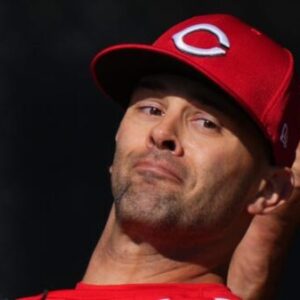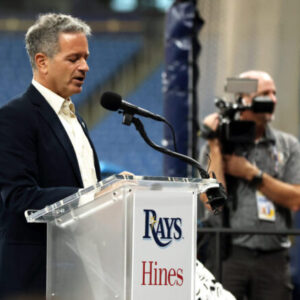Mets Trade for Jose Siri, Rays Keep On Raysingby Davy Andrews November 20, 2024Joe Nicholson-USA TODAY SportsWell, the Mets really did it. On Tuesday, they finally went out and landed the electric Dominican outfielder with the big tools and the ebullient personality, the one they’d been dreaming of for so very long. Well, they landed one of the electric Dominican outfielders they’d been dreaming of, anyway.

In a one-for-one swap, the Mets received center fielder Jose Siri from the Rays in exchange for right-handed pitching prospect Eric Orze. Siri is a thrilling player with four jaw-dropping tools: power, defense, speed, and throwing. The complete absence of a hit tool leaves him kind of like a boat with the world’s greatest bilge pump and a gaping hole in the hull.
He’s forever battling to mash enough moonshots and make enough improbable catches to stay afloat despite running a strikeout rate that falls somewhere between catastrophic and cataclysmic. In a move that will surprise no one who is even passingly familiar with the Rays, the team turned Siri into a pitching prospect the moment he could conceivably begin to cost them actual money. The Mets now control Siri for his three arbitration years, and MLB Trade Rumors projects him for a $2.
3 million salary in 2025 (plus a luxury tax penalty). Given that the trade went down Tuesday, the Rays have probably already turned Orze into a bona fide ace. The move could indicate something of a pattern for the Mets, who signed the glove-first Harrison Bader to a one-year contract before the 2024 season.
Here’s how similar the two players are: At the time of his signing, Bader was 29 years old and had posted a career wRC+ of 90 while averaging 20 OAA per 150 games. Right now, Siri is 29 years old and has posted a career wRC+ of 89 while averaging 19. 1 OAA per 150 games.
That move didn’t exactly pan out. Bader managed to avoid the injured list for the first time since 2020 and his 85 wRC+ wasn’t far below his career mark, but it wasn’t exactly the bounce-back season the Mets had hoped for. He started nearly every game against right-handed pitching, but against lefties, he went from ceding the occasional start to Tyrone Taylor at the beginning of the season to sitting more often than not by the end of it.
This wasn’t ideal considering Bader has a career 109 wRC+ vs. lefties and an 84 wRC+ vs. righties.
By the time the playoffs rolled around, he was the odd man out. He got into nearly all of the team’s postseason games, but started just twice and made just six plate appearances. In all, the Mets got just 1.
6 WAR in center field in 2024. That ranked 22nd in all of baseball, and it was the lowest ranking of any position on the field for the team. The only other spots on the diamond where the Mets were even in the bottom half of the league were starting pitcher, catcher, and right field.
With Bader and Jesse Winker entering free agency and Taylor undergoing surgery to repair a hernia and remove a loose body from his throwing elbow, Siri is unlikely to be the last outfielder the Mets acquire this offseason. The Athletic’s Will Sammon cited sources who reported that this wasn’t the first time the Mets had sought to get their hands Siri, and it’s not hard to see why. Siri is as tempting a project as any player in the game.
He’s an incredibly gifted defensive center fielder with light tower power and absolutely no semblance of plate discipline or contact ability. The team that could get him to chase just a little bit less, to whiff just a little bit less, would have a monster on its hands. However, Siri is entering his age-29 season, and it’s hard to imagine that even the team that wanted him badly enough to risk the humiliation of trading a pitching prospect to the Rays really expects to finally unlock him.
Unlike lower-back pain, plate discipline isn’t something you just happen to pick up once you hit your 30s. In 2024, Siri ran a 37. 9% strikeout rate.
Among players with 400 plate appearances in a season, that’s the third-highest mark in major league history. His 35. 8% career strikeout rate ranks 14th on our career leaderboard, and five of the 13 players ahead of him were pitchers.
Just like Bader in Flushing, Siri started losing playing time as the 2024 season went on. Jonny DeLuca, who in 2024 featured – and stop me if you’ve heard this before – excellent speed and defense to go with some trouble getting on base, absorbed that playing time and will presumably be starting in center for the Rays next season. This time, the Mets got their solid, if flawed, center fielder on the trade market because there really aren’t any to be had in free agency.
Understandably, they’re not keen to ride the Bader train again. Michael A. Taylor and Manuel Margot, the only other true center fielders on the free agent market, are both on the wrong side of 30 and coming off their own extremely down 2024 seasons.
Siri’s production may look a lot like Bader’s, but he’s got a better track record when it comes to health, and because he cost a prospect rather than a free agent contract, he’ll come with a smaller luxury cap hit. In Orze, the Rays landed a 27-year-old multi-inning reliever with a killer splitter and a modest track record of minor league success. The Mets selected him in the fifth round of the 2020 draft out of the University of New Orleans.
If you’re familiar with him already, you’re either aware that he has survived two types of cancer or you’ve heard about his unfortunate major league debut. On July 8, Orze entered in the sixth inning against the Pirates and allowed a walk and two singles without recording an out. All three runners would score and he’d be tagged with the loss to go with his infinite ERA.
Orze would make just one more appearance with the Mets. Despite an unspectacular 29. 7% chase rate in the minors in 2024, Orze has had excellent strikeout rates throughout his minor league career.
However, those strikeouts have come hand-in-hand with dangerously high walk rates. In 2022, Eric Longenhagen ranked Orze seventh in Mets system, writing that he was a “near-ready multi-inning reliever… a super valuable piece for a contending team, and a huge draft and dev feather in the cap of the org. ” Unfortunately, Orze stalled out, posting a 5.
13 ERA at Triple-A Syracuse in 2022 and a 5. 31 ERA there in 2023. After the ranked portion of the team’s 2024 prospect list, Eric wrote simply that Orze “has a plus-plus changeup and struggles to throw strikes.
” He wasn’t wrong. Among minor leaguers with at least 75 plate appearances tracked by Statcast in 2024, Orze’s 44% zone rate put him in the just 13th percentile. To be fair, Orze’s peripherals outpaced his ERA, especially in 2022.
In 2024, he had a 2. 92 ERA with a 3. 65 xFIP.
He looks like a classic pronator, able to make the ball run to his arm side at will. Both scouts and stuff models are in love with his splitter, and his slider should be serviceable. His four-seamer is the problem.
The pitch averages a hair under 94 mph, and as you can see from Max Bay’s Dynamic Dead Zone app, its movement profile is unlikely to fool too many hitters. See how the pink oval of the pitch’s actual shape matches up almost perfectly with the light blue ovals that indicate the shape that a batter would expect? That’s no good.
If the Rays are going to turn Orze into their next star, they’ll need to help him with his command, and they’ll need to help him unlock a better fastball. Still, we’ve been doing this long enough to know that when the Rays post something like this on Bluesky, everyone should be afraid. 2025 Classic Baseball Era Committee Candidate: Vic Harris Davy Andrews is a Brooklyn-based musician and a contributing writer for FanGraphs.
He can be found on Twitter @davyandrewsdavy. This post was originally published on this site be sure to check out more of their content.





